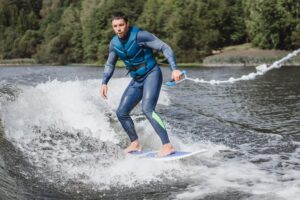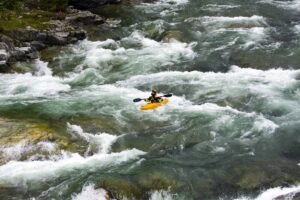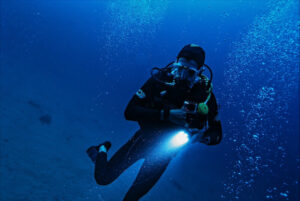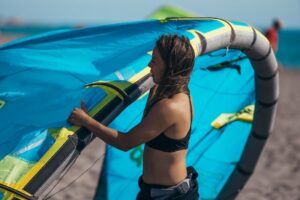Speed, height and finesse. Kiteboarding is THE most exciting and challenging way to surf in the whole diverse surfing universe. Every muscle in use, and every brain cell working to calculate the combined powers of wind and water.
Nothing ruins the fun of executing a sport more than getting frustrated over unnecessary failures. In our uncomplicated guide, you will find helpful recommendations for kitesurf spots and a comprehensive introduction of how to kitesurf for beginners. Mastering the power of wind and waves might seem like a science for itself. But if you follow a handful of easy key points, you will be ready to go and try it yourself in no time.
In this article, you will get answers to the following questions:
- How to kitesurf for beginners?
- What size kiteboard do I need?
- How high can a kite surfer jump?
- Where to kitesurf for beginners?
- Do kitesurfers have specific rules on the water?
How to Learn Kitesurfing – A Solid Foundation
Feel the wind in your hair, the sun on your face, and the thrill of adventure coursing through your veins – you’ve entered the exhilarating world of kitesurfing. Welcome to our comprehensive kitesurf guide, your passport to mastering the art of harnessing wind and water for an unforgettable ride.
This guide is your passport to the ultimate fusion of wind, water, and adrenaline. Are you ready to ride the kite and board into the heart of adventure? Let’s begin the journey.
Here are the most important facts to know when entering the world of kitesurfing:
➀ Gear and Setup
➁ Top Kitesurfing Spots
➂ Wind Conditions
➃ Your Preferred Riding Style
➄ Safety and Etiquette
Looks easy? Exactly! Get your notepad and pencil ready and off we go checking off our list… Let’s find out what is the best kiteboard size for you.
Step 1: Getting to Know the Gear and the Setup
Kite: The kite is the core component of kitesurfing gear. It includes an inflatable leading edge and a canopy, which catches the wind to generate power. Kites come in various designs, such as inflatable leading edge (LEI) kites, foil kites, and hybrid kites. They vary in size and style to suit different wind conditions and riding styles.
Kiteboard: The kiteboard is the rider’s platform. Twin-tip kiteboards are the most common, featuring a symmetrical design that allows riding in both directions. Other types include directional boards (for wave riding), foilboards, and wakestyle boards. The choice of board depends on the rider’s preferences and style and his size and weight.
Fins are attached to the bottom of the kiteboard and help with control, stability, and grip on the water’s surface. The number and shape of fins can vary based on the type of board and riding style.
Choosing the right board size depends mainly on your physique. Taller and heavier riders will need bigger boards than petite riders to stay afloat and take advantage of the full potential of the wind and waves.
We advise going smaller than the size given when:
- you want to ride in strong winds and prefer to ride powered
- you have a more playful/maneuverable riding style
- you are comparatively small for your weight
We advise going bigger than the size given when:
- you are riding with boots
- you prefer more comfort and less impact on your knees
- you are looking for better upwind abilities
- you are often riding in low wind conditions, around 15kn
Harness: A kite harness is worn around the waist or hips and is used to connect the rider to the kite via a control bar. It helps distribute the pull force from the kite and provides support, allowing the rider to control the kite with less effort.
Control Bar: The control bar is a key component for controlling the kite. It consists of a bar with lines attached to the kite. The rider uses the bar to steer the kite, adjust power, and perform maneuvers. It often includes features like a quick-release safety system.
Lines: Kite lines connect the kite to the control bar and transmit the rider’s commands to the kite. They come in different lengths, with longer lines typically used for larger kites and shorter lines for smaller kites.
Safety Gear: Safety is a top priority in kitesurfing. Riders wear safety gear, including a helmet, multiple safety leashes, an impact vest, and water-resistant sunblock. In cold-water conditions, a wetsuit is necessary to provide thermal protection.
More about the question of how to make learning kitesurfing as safe as possible, later on in the guide.
Step 2: Where to Find the Top Learning Kitesurfing destinations
Kitesurfing is a popular water sport that can be enjoyed in numerous stunning destinations around the world. The best kitesurfing destinations offer a combination of ideal wind conditions, beautiful beaches, and a vibrant kiteboarding community. Here are some of the top kitesurfing destinations offering space for learning how to kitesurf or improve your skills:
- Tarifa, Spain: Known as the “Windy Capital of Europe,” Tarifa in southern Spain offers consistent winds and a mix of conditions suitable for all levels of kitesurfers. The town also boasts a lively atmosphere and a vibrant nightlife.
- Cumbuco, Brazil: Cumbuco is famous for its strong and consistent winds, making it a favorite for freestyle riders. The wide sandy beaches and flatwater lagoons provide excellent kitesurfing conditions.
- Fuerteventura, Canary Islands: With its strong winds and consistent conditions, Fuerteventura is a top destination for kiteboarders. The island offers a mix of flatwater lagoons and wave spots.
- Cape Hatteras, North Carolina, USA: Known as the “Outer Banks,” Cape Hatteras is a top kitesurfing destination on the East Coast of the United States. It features consistent winds and shallow water, making it great for beginners.
These are just a few of the top kitesurfing destinations worldwide. Keep in mind that the suitability of a destination can vary based on your skill level, riding style, and preferred conditions. Additionally, always check local regulations and safety guidelines when planning your kiteboarding trips.
Step 3: Reading the Wind
Wind speed is measured in knots (1 knot = 1.15 mph or 1.85 km/h). An anemometer, a wind measuring device, can provide accurate wind speed readings.
Generally, learning kitesurfing is best enjoyed in wind speeds ranging from 12 to 30 knots, but ideal conditions can vary based on your experience level and equipment.
Light Wind (5-10 knots): In light wind conditions, you’ll want a larger kiteboard with more surface area. A larger board provides better flotation, allowing you to get up on the plane and ride efficiently even when the wind is weak.
Moderate Wind (10-20 knots): Moderate wind conditions are ideal for a range of kiteboard sizes, depending on your skill level and riding style. A medium-sized board is suitable for most riders during these conditions, offering a balance between control and maneuverability.
Strong Wind (20+ knots): In strong wind conditions, smaller kiteboards are preferred. A smaller board provides better control and maneuverability, allowing you to handle the higher wind speeds and maintain stability.
Understanding the wind direction is essential. The wind should be blowing onto the shore or parallel to it. Avoid offshore winds as they can carry you out to sea, making it difficult to return.
Look for wind indicators on the beach, such as flags or windsocks. Pay attention to how they are blowing to gauge wind direction and speed. Landmarks, such as trees or buildings, can also give you clues about the wind’s behavior.
Observe the movement of clouds in the sky. Generally, puffy, white cumulus clouds can indicate gusty winds, while darker, heavier clouds may signify a weather change. Be cautious in gusty conditions.
Always prioritize safety when reading the wind. Assess your own skill level and whether the wind conditions are suitable for your abilities. If in doubt or if conditions are beyond your comfort zone, seek guidance from experienced kitesurfers or instructors.
Step 4: Your Riding Style
Kiteboarding offers a variety of riding styles, each catering to different preferences and skill levels. The choice of riding style determines the type of equipment used, the conditions required, and the maneuvers performed.
The five main categories are Freeride, Freestyle, Wakestyle, Waveriding and Big Air. Kiteboarding enthusiasts often explore multiple riding styles over time, depending on their skill progression, local conditions, and changing interests. The diversity of styles is one of the many attractions of kiteboarding.
Freeride is the most popular and versatile riding style. It’s all about enjoying the thrill of kiteboarding in a relaxed and casual manner. Riders in this style cruise along the water, jump, and perform basic tricks.
On the other hand, Freestyle kiteboarding focuses on performing tricks and aerial maneuvers. Riders aim for style and creativity in their jumps, spins, grabs, and unhooked tricks.
Closely related to Wakeboarding, Wakestyle is performed in kite parks and cable parks, where kiteboarders use obstacles like sliders, kickers, and rails to perform tricks.
Wave riding, also known as wave kitesurfing, emulates traditional surfing but with the added power of a kite. Riders surf ocean waves, using the kite for speed and control.
The probably most spectacular kiteboarding style you could choose must be Big air kiteboarding. It is all about achieving maximum height and airtime in jumps. Riders choose larger and more buoyant boards, which help generate lift and provide a stable platform for high jumps. This style often leads to spectacular aerial tricks.
But whichever category you select – Remember to always prioritize safety!
Step 5: Safety and Etiquette in Kitesurfing
Learning kitesurfing, like any sport, has its own etiquette and rules to ensure safety, courtesy, and an enjoyable experience for everyone. Understanding and following these guidelines is essential for a positive kitesurfing environment.
High speeds and altitude, potential for collisions, and the highly powerful equipment make kitesurfing not only risky for your own health, but for the lifes of your fellow surfers as well.
So make sure to use your safety gear precisely. A board leash is used to prevent the board from drifting away if the rider becomes separated from it.
A safety leash is attached to the rider’s harness or wrist and connects to the kite’s safety system. It allows the rider to release the kite in emergency situations, preventing the kite from flying uncontrollably.
Besides that, a helmet, impact vest, and water-resistant sunblock can help you, preventing bigger injuries in (the very like) case of crashes or aggressive sun rays.
Kitesurfing Etiquette:
☞ Respect the Environment: Avoid damaging sensitive ecosystems and wildlife. Dispose of trash properly and respect local environmental regulations.
☞ Share the Space: Be considerate of other beachgoers, swimmers, and water users. Stay away from crowded areas and give right of way to others in the water.
☞ Local Regulations: Familiarize yourself with local kitesurfing regulations, which can vary from one spot to another. Some locations have specific rules and launch areas.
☞ Communicate: Use hand signals and clear communication with other kiters on the water. Signal your intentions and any issues you encounter.
☞ Emergency Procedures: Learn and practice emergency procedures, such as self-rescue techniques and quick kite depower. Being prepared can prevent dangerous situations.
☞ Apologize for Mistakes: If you make a mistake or inadvertently interfere with someone else’s ride, offer a sincere apology to maintain a positive atmosphere on the water.
How to Kitesurf for Beginners – A Step-by-Step Guide
Kitesurfing can be challenging at first, but with patience and practice, you will improve your skills and gain confidence. In the following, you can learn the basic steps of kitesurfing chronologically from the first careful tries on land, to tricks like spins and jumps on the water and in the air.
It is highly recommended to visit a kiteboarding school and always have an experienced kitesurfer or instructor with you for your first attempts. They can provide guidance, support, and, if needed, rescue in case of trouble.
On land, you can begin your practice on the beach or in shallow water. You will probably be working with a smaller training kite at this stage. Practice controlling the kite. Feel how the kite responds to your bar inputs, and learn to generate power in the kite by flying it through the wind window.
Understand the wind window, which is the area where the kite generates power. Position yourself at the edge of the wind window, generally with the kite slightly downwind and overhead.
Now it is time to prepare your kite. Lay out the kite on the ground with the leading edge facing the wind. Unfold the kite, ensuring the lines are not tangled.
Connect the kite’s lines to the control bar following the manufacturer’s instructions. Check that the lines are correctly attached to the correct line attachment points on the kite.
Verify that your kite’s safety systems, such as the quick-release mechanism and safety leash, are in working order and ready to deploy if necessary.
Progress to body dragging in the water. Body dragging involves using the kite to pull yourself through the water while lying on your stomach. It’s a fundamental skill that helps you understand the kite’s power and how it affects your movement in the water.
Once you’re comfortable with body dragging, it’s time to attempt a water start. A water start involves getting up on the board and riding. Here’s how to do it:
☞ Position yourself in the water with the kite above you, leading edge down and about 45 degrees to the wind.
☞ Place your feet into the foot straps on the board.
☞ Use the kite’s power to pull yourself up out of the water while simultaneously steering the kite to generate power.
☞ As you rise out of the water, keep your weight on the back foot to maintain balance and prevent the kite from pulling you too far forward.
Once you’re on the board, practice riding upwind, which is crucial for controlling your position and returning to your starting point.
Launching:
☞ Hold the control bar with both hands, keeping the kite’s leading edge on the ground.
☞ Inform your assistant that you are ready to launch by signaling or calling out.
☞ Your assistant should hold the kite at the wingtip and walk upwind to launch it. They should then gently lift the kite into the air, allowing it to catch the wind and rise slowly.
☞ As the kite gains altitude, maintain control of the control bar. Keep your arms extended and be ready to react to any sudden movements.
Once the kite is in the air, practice flying it in a controlled manner. Avoid sharp movements or pulling too hard on the bar. Gradually steer the kite through the wind window to generate power.
Learning kitesurfing is a full body workout. Once your muscles get tired, it is time to return to the shore and give your body a well-deserved rest. Start by riding toward the shore or your designated landing area. Make sure to keep an eye on your surroundings and maintain control of your kite.
Gradually depower your kite by adjusting the angle of the kite’s leading edge using the control bar. This will reduce the kite’s power and slow you down.
As you approach the shore, prepare to dismount from the board. Position yourself so that you are perpendicular to the wind, which will help you land more smoothly.
When you’re close to the shore and the water is shallow enough, prepare to dismount from the board. You can do this by lifting your feet out of the foot straps and standing up in the water.
Keep your kite flying at a slightly higher angle to maintain balance and stability as you dismount. Use the kite’s power to support your body in the water.
Once you’re safely onshore, it’s time to land the kite. Walk toward the kite while maintaining tension on the lines. This will bring the kite down in a controlled manner.
After landing, store your kiteboarding gear properly. Rinse off your equipment with fresh water to remove any salt or sand, and ensure it’s in good condition for your next session.
Conclusion: How to Kitesurf
Kitesurfing is not just a sport, it’s a lifestyle that connects you with nature and a vibrant community of fellow enthusiasts. It’s a journey that requires patience, respect for nature, and dedication to safety. Prioritize proper training, stay vigilant about wind conditions, and adhere to safety protocols and etiquette.
Seek guidance from experienced instructors and fellow kiters to enhance your skills and knowledge. So, take the first step, embrace the challenge, and embark on a journey that promises unforgettable moments and a lifelong connection to the elements.
FAQ – Most asked question about learning kitesurfing
Depending on your own height and weight, you will want to adjust the kite board’s length and volume. Kiteboard sizes range from 134 cm up to 165 cm. The bigger the kite board, the easier it should be to keep balance, but also the less maneuverability it offers.
Fitness, Balance, and Confidence! Kitesurfing is a sport, and as any sport, it requires a certain level of fitness. Fitness ensures balance and safety, and will help prevent injuries.
Besides being an incredible experience in a stunning location, learning kitesurfing brings a bunch of benefits. Starting with toning your body, relieving stress, a vitamin D boost, increasing the level of concentration to networking. Done right, learning kitesurfing can even help keeping your heart healthy, with the mixture of aerobics and exercise.








